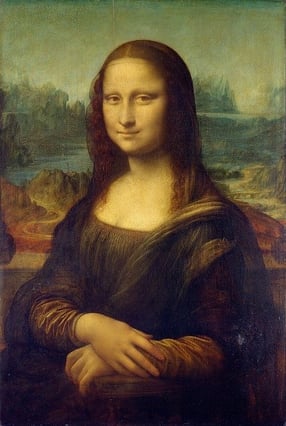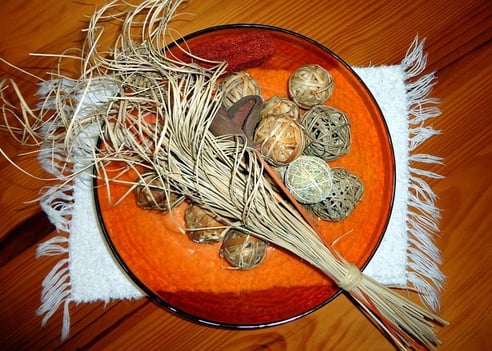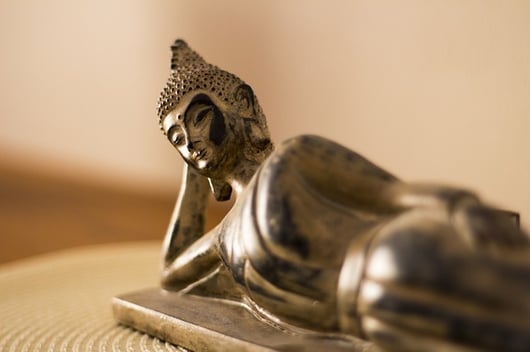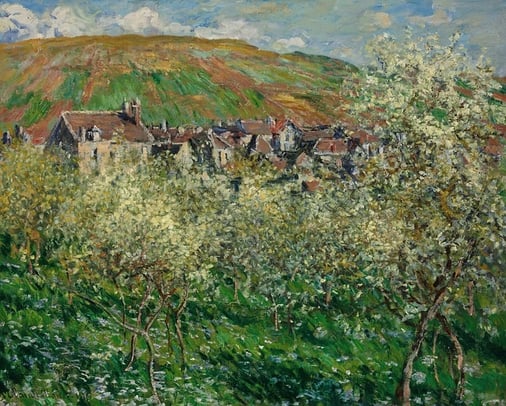Ap Art History Short Answer Questions Question 6 2018 Sample Response
Thinking about taking AP Fine art History but aren't certain what information technology covers? AP Fine art History differs from other AP arts courses in that you lot're not creating your own art--instead, you're learning about the huge variety of art that has been created beyond time and around the world. The class covers a lot of basis, and knowing what to expect from the start can assist you accept a productive and manageable year. In this guide, we'll look at what students acquire in AP Art History, what the AP Fine art History test is similar, if the course is considered hard, and resource and tips yous can use to help y'all ace the course and the AP examination. AP Art History is designed to give students broad knowledge in a variety of creative forms and styles across the globe and over the course of human history. The course covers six continents and over 30,000 years of art history. Students who accept the course acquire how to critically examine a wide variety of art and express their thoughts on it. There are roughly 250 works of art (known as the AP Art History 250) you're expected to know as an AP Art History student. (If that terrifies you, know that the list used to stretch to over 500 earlier the 2015-2016 course update!) For each AP Art History 250 piece, you lot'll larn facts well-nigh the art, its cosmos, and how information technology fits into larger art history patterns. At that place are ten units in AP Art History, each roofing a specific region and time frame. You can read the AP Art History Course and Test Description for an in-depth look at each major topic the class covers. Below is an overview of the 10 units along with the percentage of questions you can wait to focus on that unit in the multiple-choice section of the AP exam. Unit of measurement one: Global Prehistory, 30,000-500 BCE Unit ii: Ancient Mediterranean, 3500 BCE-300 CE Unit iii: Early Europe and Colonial Americas, 200-1750 CE Unit iv: Later Europe and Americas, 1750-1980 CE Unit 5: Indigenous Americas, 1000 BCE-1980 CE Unit 6: Africa, 1100-1980 CE Unit seven: West and Central Asia, 500 BCE-1980 CE Unit 8: South, E, and Southeast Asia, 300 BCE-1980 CE Unit ix: The Pacific, 700-1980 CE Unit 10: Global Gimmicky, 1980 CE to Present Equally with most AP exams, Fine art History'south is split into ii parts: multiple pick, followed by free response. The chart below gives an overview of the exam format: Section Question Type # of Questions Time % of Score 1 Multiple Choice 80 one hour l% two Free Response 2 long essays 4 brusk essays 2 hours l% For the multiple-choice section, you lot'll have an hour to reply 80 questions. The questions can exist sets of 2-iii related questions, or individual questions. Each question is based on a color paradigm of a work of fine art. For this section you'll be asked to: For the free-response section, at that place are vi questions. Here's what you'll need to practice for each: Question 1: Long Essay–Compare a required work of art and another of your choosing and explain the significance of the similarities and differences between those works, citing testify to support your claim. Question 2: Long Essay–Select and identify a work of art and brand assertions about it based on evidence. Question 3: Brusk Essay–Depict a work of art across the paradigm[due south] provided in the prompt and connect it to an creative tradition, style, or practice. Question 4: Short Essay–Describe contextual influences of a work of art in the image set and explain how context tin influence creative decisions or impact the pregnant of a piece of work of art. Question five: Short Essay–Attribute a work of fine art beyond the epitome set to a item artist, civilization, or mode, and justify your assertions with bear witness. Question 6: Curt Essay–Clarify the human relationship between a provided piece of work of fine art and a related artistic tradition, fashion, or practice. Question ane is worth 8 points, Question 2 is worth 6 points, and Questions 3-half-dozen are each worth 5 points. The free-response department as a whole is worth 50% of your total AP score. Is AP Fine art History hard? It certainly covers a lot of information and requires yous to use multiple skills, only how does information technology compare to other AP courses and exams? We have an entire article on the toughest AP classes and tests, but in this department we'll analyze AP Art History specifically. To outset, let'due south look at some data. Hither's how students scored on the AP Fine art History examination in 2021: AP Score 5 4 3 ii 1 % Receiving Score 12.0% xix.6% 23.8% xxx.one% 14.6% There are two measurements we can look at to decide AP Fine art History difficulty. The first is the v rate, or what percentage of exam takers earned the highest score on the exam. The 5 charge per unit for AP Art History is 12%, which is roughly the average for all AP exams. The other measurement is the passing charge per unit, or what per centum of exam takers earned a iii or higher. Fine art History has a passing rate of 55% which is below average. Out of 44 exams, only 12 had a lower passing charge per unit than Fine art History. This means that Art History may be harder than the average AP course. From forums like College Confidential, Reddit, and Quora, we know that, even though many students think the course material and examination questions are fairly straightforward, the sheer corporeality of data you need to know--most unlike types of art, different regions, dissimilar styles etc. can make information technology difficult to do well in Fine art History. Another way to gauge the difficulty of AP Fine art History is to ask onetime students their opinions. Maybe your school has a actually great Art History teacher who makes the material interesting and easier to understand. Or possibly the class is known for having a ton of homework that makes it difficult to notice time for your other classes. Whichever resources you use to decide if AP Art History is hard or non, call back to take all that information with a grain of salt. What'due south difficult for one person tin be piece of cake for some other. If you take a genuine involvement in art history, you'll likely take an easier time than someone who doesn't because you'll be more motivated to larn all the information required. Similarly, if you are naturally good at memorizing facts, y'all may fare better than someone who tin't keep dates or names directly just is fantabulous at wide analysis, simply considering of the blazon of course AP Art History is. Now yous know what to expect from the AP Art History course and exam, but the question remains: should you have AP Art History? The respond actually depends on how y'all personally feel most the course and the fabric information technology covers. As we mentioned above, Art History tin can be a tough AP course with a lot of memorization and homework required to do well. If you don't have an interest in the bailiwick, that can make information technology a slog to go through the class. However, because fine art history is an interdisciplinary subject area, it can entreatment to a lot of students, including those interested in history, art, different cultures, and social science in general. If you're interested in fine arts, it tin be an especially skillful option because information technology's a examination-based AP (as opposed to portfolio-based APs like 3D and 2d Art) that allows you to study art just as well prove off your writing and exam-taking skills to colleges. Many times loftier school students experience pressured to accept "impressive" classes that they think will look good on their college applications, and they want to know how colleges will view AP Fine art History. The truth is that, since information technology's an AP grade, AP Fine art History will automatically await skillful on your transcript and will be more impressive than a regular-level or honors-level form. Many colleges do tend to see Stalk AP courses (like AP Biology, Calculus, etc.) equally a bit more impressive, but if you're really interested in the cloth, sign up for AP Art History! You'll likely go a higher grade on the AP exam than you would in a course yous don't care about, and a loftier AP score is some other bonus for you. Practice tests are one of the best means to report for an AP examination, but only if you're using the right materials. In this section nosotros cover the all-time AP Fine art History study resource to get your prep off on the right foot. Official practice materials are the absolute all-time to use for whatever AP exam. They're made past the same people who pattern the actual AP exam questions, so you know their exercise materials will be high quality. For free-response questions, you tin can access dozens of erstwhile AP Art History exam questions and respond explanations on the AP site. These are a smashing resources, and you should exist sure to make use of them. More recent questions (2016 and subsequently) will be more useful since they'll be in line with the current format of the examination. Additionally, the AP Fine art History Form and Test Description contains fifteen multiple-choice questions and three free-response questions first on folio 327 of the document. Considering in that location are so many official complimentary-response questions available, nosotros recommend using only them for your prep. Salvage unofficial resources for multiple-pick questions. There are quite a few unofficial resources for AP Art History practice questions; unfortunately, many of them are depression quality and non worth your time. A good rule of thumb is that, if the multiple-choice questions aren't accompanied by an image of a piece of work of art, they aren't close to what you'll see on the bodily AP test and should be avoided. Correct now Albert is the only really solid unofficial online resource. You'll have to create an business relationship to access the materials, and, additionally, some questions require a paid account on top of that, but their questions are high-quality and a good friction match to the bodily exam. There are likewise prep books available that include practice exams. These tin can be a helpful resources but, like any other unofficial fabric, be sure to read reviews carefully before buying one. Once you have your study materials in hand, follow the 3 tips outlined below to ace both sections of the AP Art History exam. As we mentioned above, you lot'll demand to know the AP Art History 250 works of art. For each one, yous should be able to rattle off the title, artist, engagement and location of creation, and a fact or 2 virtually its importance. All together, that's over a thousand bits of information you'll demand to keep straight. Flashcards will be your friend! Once you lot've created your set of flashcards, we recommend using the waterfall method every bit the best mode to drill down into the cards y'all don't know and memorize all the information as efficiently and hands as possible. Just memorizing facts isn't enough to exercise well in AP Art History; you lot also demand to be able to analyze dissimilar works of fine art and discuss their similarities, differences, and relation to the region and time period every bit a whole. You lot'll probable exist doing a lot of this in class, simply because it'south such an important skill, make sure to spend fourth dimension on it outside of class as well. Every bit you're going through your flashcards, draw a couple cards randomly and try to make connections betwixt them. What characteristics practice they share? How do they differ? What changes in the world contributed to these differences? If yous need help getting started, the gratis-response questions on the AP website are a great place to run into the types of questions y'all might be asked (as well every bit what stiff answers look like). A time crunch is always present on AP exams, and Art History is no exception. For the multiple-pick department, yous'll have 60 minutes to answer 80 questions, which gives you 45 seconds per question. For virtually people, this is doable as long every bit they don't get tripped upward and spend several minutes struggling over a single question. For the free-response section, fourth dimension force per unit area is often even greater because you lot'll take to write what are effectively six curt essays. It's very easy to become caught up in one essay and all of a sudden realize that in that location are ten minutes left in the section and yous haven't fifty-fifty started the terminal 2 essay questions. Don't allow this happen to yous! At a minimum, y'all should suspension for a moment at the midway signal of each section (that's 30 minutes into the multiple-choice section and one hour into the free-response section) and appraise how yous're doing for time. Take you answered about half of the questions? Then you can continue the stride yous're at. If not, then you know you need to speed things upwardly. It's also of import to be OK with skipping questions. If you've spent over a minute staring at a multiple-choice problem and all the same have no thought how to answer it, mark a random reply and come up back to information technology if you have extra time at the end of the section. For free response, don't be afraid to answer the questions out of order. And keep to about 20 minutes per essay in society to take enough time to reply each of the questions. AP Art History covers the history of fine art spanning six continents and over thirty,000 years. Students who take the course volition acquire how to analyze and hash out various works of fine art (including the AP Art History 250). Is AP Fine art History hard? Students often mention the big corporeality of information you need to memorize, and the AP exam has a lower passing rate than average, but don't allow that dissuade you if you're interested in the course material. If you do make up one's mind to take the grade, be sure to make use of flashcards, go lots of practise making connections between works of art, and keep track of time throughout the AP examination. Is art school in your future? Read our guide on the ten all-time art schools in the US to get an overview of the top options. If you're planning on going to art schoolhouse, you'll need to create a portfolio of your all-time work. Larn more than nearly how to make a bang-up portfolio that will impress your dream school. If you're worried about paying for college, at that place are tons of scholarships out there for you. Read this article on the all-time scholarships you can win every bit a high school senior. Looking for help studying for your AP test? Our one-on-ane online AP tutoring services tin can help you lot prepare for your AP exams. Get matched with a top tutor who got a high score on the test you're studying for! 
What Does AP Art History Cover?

What's the Exam Format for AP Fine art History?
How Hard Is AP Art History?

Should You Take AP Fine art History?
AP Art History Do Tests
Official Practice Tests
Unofficial Practice Tests
iii Report Tips for AP Fine art History
#i: Go Friendly With Flashcards
#two: Make Connections Between Works of Art
#3: Go along Runway of Time

Summary: What Is AP Art History?
What's Next?


About the Writer
Christine graduated from Michigan Land University with degrees in Environmental Biology and Geography and received her Master'south from Duke University. In loftier school she scored in the 99th percentile on the Saturday and was named a National Merit Finalist. She has taught English language and biology in several countries.
Source: https://blog.prepscholar.com/what-is-ap-art-history
0 Response to "Ap Art History Short Answer Questions Question 6 2018 Sample Response"
Post a Comment